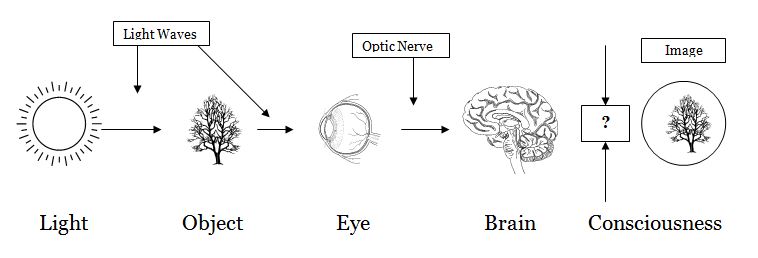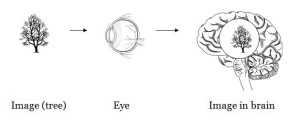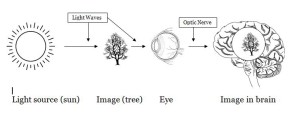The Eye of the Mind – Part Two
The mystics claim that the world we think of as real, is actually a subjective phenomenon appearing in the mind that we have learned to project outside of ourselves.
But this conflicting view of the world leaves us with a mystifying conundrum. For if the world we see and interact with has a subjective nature that is projected by our minds, then how is it that our senses are able to respond to the world as if it had an objective reality?
If the mystics are correct, then there must be some fundamental flaw in the scientific interpretation of the way in which our senses operate. In order to find this flaw, we need to investigate the scientific explanation of the process whereby the outer world comes to reveal itself to our minds.
For example, let us examine how our sense of sight conveys information about the outside world to our brains according to accepted scientific theory. When we look at a tree, we see it by means of our eyes, and the image of the tree is conveyed from our eyes to the brain. The brain then furnishes the image of the tree in our minds.
So we may illustrate this process in the following rudimentary fashion.
In order to see the tree, however, there must be sufficient light. If there was complete darkness, we would be unable to see anything at all. If we assume that the sun is shining, and that the tree is illuminated by the light of the sun in the form of various rays of light, then these light waves are reflected by the tree, and these reflected light waves penetrate the eye.
Once the light enters the eye, the lens of the eye causes an inverted image of the tree to be displayed on the retina, at the back of the eyeball. This inverted image is then conveyed to the brain by means of the optic nerve, and is then converted by the brain into the mental image of the tree, as shown below.
In order to see the tree, it is necessary for photons (electromagnetic particles of light) to strike the tree. These photons are then reflected by the tree, and when they enter the eye they are focused on the retina.
By a process of electrical and chemical transmission, the information registered upon the retina is conveyed to the brain along the optic nerve. These signals finally reach the visual control centre of the cerebral cortex, where they are converted into the final image of the tree.
It is important to recognise that between the sun, the tree and the eye, there exists only electromagnetic radiation, in the form of photons of light. There can be no question at this stage of any image of a tree. There are merely particles of light, or, as we have learned from their complementary nature, wave-particles of energy.
When this energy meets the receptor cells located in the retina, it is converted into electrical information by a process known as transduction, and is then routed via the optic nerve to the thalamus in the brain.
The thalamus is a type of relay station, which then passes the information received along the optic nerve, through another set of nerve fibres, to the primary visual cortex at the back of the brain. When these signals reach this portion of the brain, they still have to be deciphered.
It is the action of the visual cortex that finally creates the picture of the tree which then appears in consciousness. It is only when all the various signals are combined in consciousness, that a visual image of the tree becomes possible, and we actually get to “see” the tree.
This visual image is assumed to be a true reflection of the object that actually exists out there in space. We assume that the signals relayed to us by our senses have in fact been transmitted with true fidelity. But we have no way of knowing whether they have done so correctly or not.
The image which has formed itself in our consciousness is the only image we know, and it is this image in our consciousness which is then projected by our mind, as an actual object existing in three-dimensional space.
When we say that we “see” something, therefore, what we are really doing is identifying an image in our minds, and then projecting this image into space as a physical object.
We never therefore actually see anything “out there” at all. Everything that we see simply consists of various impressions registered upon our consciousness. Now let us examine a little more closely the process whereby the image of the tree is created in consciousness.
There are various stages in this process, which we can now identify as follows:
 The signals from the tree to the eye are conveyed by electromagnetic radiation in the form of light waves, or photons. These signals form an inverted image upon the retina of the eye.
The signals from the tree to the eye are conveyed by electromagnetic radiation in the form of light waves, or photons. These signals form an inverted image upon the retina of the eye.
Embedded within the human retina are over one hundred and thirty million photoreceptors. The photoreceptors are tiny cells that convert light into neural activity, and this nervous energy then travels by way of various nerve fibres to the brain.
There are two basic types of photoreceptor cells, one known as rods and the other as cones. The rods are sensitive to dim light but provide very little detail, while the cones identify colours and sharp details.
When a photon of light strikes one of these photoreceptor cells, a process known as transduction takes place. The electromagnetic energy of light is converted into electrical information which is then relayed to the thalamus in the brain via the optic nerve.
When these signals reach the thalamus, they are then relayed again to that part of the cerebral cortex which is responsible for vision. It is only when these signals reach the visual centre of the cerebral cortex that they are finally converted into the mental image which then appears in consciousness.
We have now reached the heart of the process of perception, and it is at this stage that the nature of sight becomes extremely mysterious. The tree that we believe we see “out there” in space, is actually an image which exists in our own consciousness.
But how is this image created in our consciousness? How are the electrical signals, which are conveyed to the brain by means of the nervous system, converted into the mental image of a tree? The problem is simply this. How does an electrical impulse become an image in consciousness?
Since we believe that it is the action of the brain that creates the image of the tree, it is clear that there must exist some special cells within the brain that are responsible for this remarkable function. Furthermore, these cells must be the most wonderful and complex cells within the entire body.
But when we trace the network of nerve signals to their ultimate destination, we discover the extraordinary fact that the cells, which are apparently responsible for this amazing ability of creating thoughts from electrical energy, are no different from any other nerve cells in the body.
By some astonishing legerdemain, our exquisitely complex function of sight appears to be the product of the most common form of cellular life. As Charles Muses trenchantly observes:
“Even in the hypothalamus, often thought of as a prime ‘center’, what we have is not a source but only a concentrated bundle of fibres. When impulses have been traced further than even concentrated bundles, we end up with specific neurons. But these are specialised amoebas, and by accepted evolutionary theory, protozoan sensibility cannot be regarded as the executive suite of human intelligence!” 1
We are therefore faced with a mystifying riddle. How is it that these simple nerve cells, which have been found to comprise the visual centre of the cerebral cortex, are able to perform this stupefying trick of creating images in consciousness, as well as the thoughts that are associated with them? In spite of its accumulation of knowledge over four hundred years, science has still been unable to solve this riddle.
The fact is that we simply do not know how it is we really get to see, or hear, or smell, taste or touch!
(Continued in Part Three)
References
1 Charles Muses, “Paraphysics: A New View of Ourselves and the Cosmos“, in “Future Science”, edited by John White and Stanley Krippner, Anchor, New York, 1977, p. 283.






